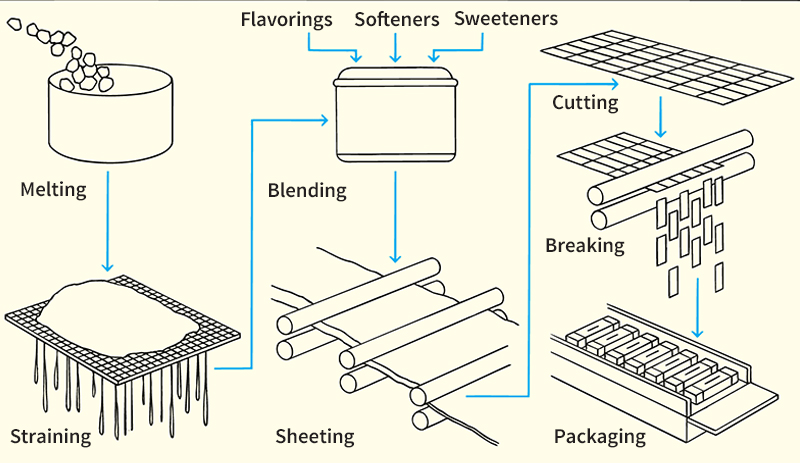Chewing gum is a type of confection that people chew but do not swallow. It comes in a variety of shapes, including sticks, balls, pellets, and chunks. The most popular flavors of gum are spearmint, peppermint, cinnamon, and fruit flavors. Many people find that gum chewing helps increase concentration and relieve boredom. In addition, studies have shown that gum chewing helps people relax.
Ingredients.
Standard chewing gum consists of five basic ingredients: gum base, sugar, corn syrup, softeners, and flavorings. Gum base is the insoluble part of the gum—that is, it does not dissolve during chewing. It makes gum chewy and acts as a base for the other ingredients. Gum base is made of various waxes, resins (sticky substances from plants and trees), and latexes (milky juices found in plants). The gum base in bubble gum is firmer and more elastic than the base in other chewing gum. This stretchier base allows the chewer to blow gum bubbles.

Sugar sweetens the gum. Corn syrup keeps the gum fresh and flexible and helps sweeten it. Softeners, such as vegetable oil products, help blend the ingredients and keep the gum soft by retaining moisture. Flavorings make the gum tasty. They come from spearmint and peppermint plants, fruits, and spices. Some gum is made without sugar or corn syrup. This sugarfree gum is made with such natural and artificial sweeteners as sorbitol, mannitol, aspartame, and saccharin.
How gum is made.
The manufacturing process for gum varies according to the gum’s type and shape. But generally, the ingredients of the gum base are first ground, melted, and purified. All the ingredients are then slowly blended in mixing machines. To make stick gum, the ingredients are passed through a series of rollers that form the gum into a wide sheet. The sheet is lightly covered with finely powdered sugar or sugar substitute to prevent sticking and to provide sweetness. Next, the sheet is scored (cut) and broken into sticks. The gum is then cooled and hardened in a room where temperature and humidity are carefully controlled. Finally, high-speed machines wrap and package the gum.

History.
The ancient Greeks chewed mastiche, a gum they made from a resin found in the bark of the mastic tree. More than 1,000 years ago, the Maya Indians of Mexico chewed chicle, a gummy substance made from the latex of the sapodilla tree. Later, Indians in New England taught American colonists to chew the hardened sap from the spruce tree. About 1850, sweetened paraffin wax became more popular than spruce gum.
The type of chewing gum known today had its beginnings in the late 1860’s. At that time, some chicle was brought to the United States from Mexico to be sold as a type of rubber. A New York City inventor named Thomas Adams, Sr., tried to make chicle into rubber but found that it would not harden. When Adams boiled the chicle, however, he found that it made excellent chewing gum. This kind of gum soon won favor over spruce and paraffin gum. Bubble gum was first produced in 1906, but it was not perfected and marketed until 1928.
In the mid-1960’s, chewing gum companies began to manufacture sugarfree gum. Many dentists recommend sugarfree gum because they believe sugar can contribute to tooth decay. But research suggests that the sugar in regular gum separates from the other ingredients, and that the washing effect of saliva produced during chewing lessens the possibility of tooth decay. Chewing gum is not harmful if it is accidentally swallowed.
Today, hundreds of companies throughout the world produce chewing gum. The United States ranks as the major producer. Other gum-producing countries include Canada, France, Italy, Japan, and the United Kingdom.
See also Bubble gum ; Chicle ; Latex ; Sapodilla .
